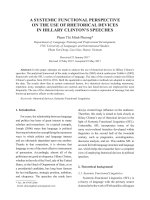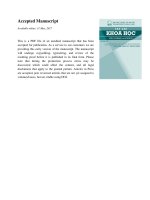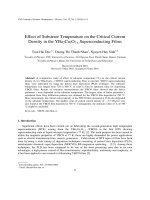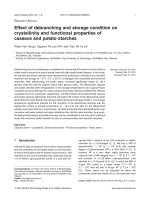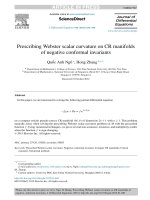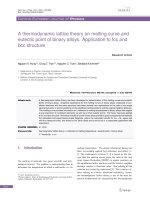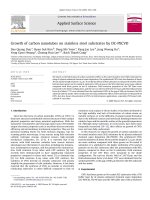DSpace at VNU: Influence of Cr Doping on the Critical Behavior of Amorphous Alloy Ribbons Fe78-xCrxSi4Nb5B12Cu1
Bạn đang xem bản rút gọn của tài liệu. Xem và tải ngay bản đầy đủ của tài liệu tại đây (1.13 MB, 4 trang )
IEEE TRANSACTIONS ON MAGNETICS, VOL. 50, NO. 11, NOVEMBER 2014
1200104
Influence of Cr Doping on the Critical Behavior of
Amorphous Alloy Ribbons Fe78−xCrxSi4Nb5B12Cu1
T. L. Phan1 , P. Q. Thanh2, N. Chau2 , C. X. Huu3 ,
D.-T. Ngo4 , T. A. Ho1 , T. D. Thanh1,5, and S. C. Yu1
1 Department
of Physics, Chungbuk National University, Cheongju 361-763, Korea
of Physics, Hanoi University of Science, Vietnam National University, Hanoi, Vietnam
3 Department of Electronics and Communication Engineering, Danang University of Technology, Danang, Vietnam
4 Department of Micro- and Nanotechnology, and Department of Energy and Storage,
Technical University of Denmark, Kgs. Lyngby 2800, Denmark
5 Institute of Materials Science, Vietnam Academy of Science and Technology, Hanoi, Vietnam
2 Faculty
Though many previous works focused on studying Cr-doped Fe–Si–Nb–B–Cu amorphous alloys, magnetic-interaction mechanisms
in these materials have not been carefully investigated yet. Dealing with these issues, we have prepared the amorphous alloy ribbons
Fe78−x Cr x Si4 Nb5 B12 Cu1 with x = 1, 3, and 6, and then studied their magnetic and critical properties. Magnetization versus
temperature and magnetic-field measurements, MHT, performed on a vibrating sample magnetometer reveal that the Cr-content
increase in Fe78−x Cr x Si4 Nb5 B12 Cu1 reduces the T C from 430 K for x = 1 to about 322 K (for x = 6). This indicates the decline
of ferromagnetic (FM) exchange interactions between Fe atoms when there is the presence of Cr atoms. We have also analyzed the
M(H) data at the temperatures in the vicinity of the T C using the modified Arrott plot method and the scaling hypothesis, and
determined the values of the critical exponents β = 0.367–0.376 and γ = 1.315–1.338. These values are close to those expected for
the 3-D Heisenberg model with β = 0.365 and γ = 1.336, proving the existence of short-range FM order in the amorphous alloy
ribbons.
Index Terms— Critical behavior, Fe-based alloy ribbons, short-range ferromagnetism.
I. I NTRODUCTION
I
T HAS been known that Fe-based amorphous alloys (either
in the bulk or ribbon form) exhibit many noticeable properties, which can give a large saturation magnetization and
the soft-magnetic behavior [1]. Depending on the application
aspects, these properties can be easily modified by changing
elemental composition of alloys. It has been realized that the
presence of Nb, Si, B, Cu, and Cr in Fe-based amorphous
alloys improves remarkably the corrosion resistance and the
soft-magnetic behavior [1]–[3]. Particularly, the formation of
the amorphous phase becomes easy when many chemical
elements are simultaneously combined in Fe-based alloys
because of structural disorders related to the difference in
the atomic radii of the elements. This also changes the
ferromagnetic–paramagnetic (FM–PM) phase-transition temperature (the Curie temperature, TC ). Based on these important
features, it has been fabricated and investigated the amorphous alloys for magnetic refrigeration applications using the
magnetocaloric effect [4]–[6]. For conventional applications
in cooling systems, the TC of the amorphous alloys can
be controlled in the temperature range of 260–310 K. For
example, the TC values (>400 K) of amorphous alloys ribbons
Fe78 Nb5 Si4 B12 Cu1 and Fe73.5 Nb3 Si13.5 B9 Au1 can be reduced
to lower temperatures by substituting partly Fe atoms by
Cr ones [4], [7], [8].
In reference to our work, there were many previous studies
on Cr-doped Fe–Nb–Si–B–Cu-based amorphous alloy ribbons
[2], [4], [7], [9]. However, magnetic interactions in these
Manuscript received March 2, 2014; accepted May 17, 2014. Date of
current version November 18, 2014. Corresponding author: S. C. Yu (e-mail:
).
Color versions of one or more of the figures in this paper are available
online at .
Digital Object Identifier 10.1109/TMAG.2014.2325949
materials and their FM–PM phase-transition type have not
been carefully studied yet. It has been shown that the study
of the critical properties based on the Arrott plot method
and the scaling hypothesis [10]–[12] are considered as an
effect approach to elucidate the mentioned issues. In this
paper, we present a thorough study on the magnetic properties
of amorphous alloy ribbons Fe78−x Crx Si4 Nb5 B12 Cu1 . The
experimental results reveal that the Cr-content increase reduces
remarkably the TC from 430 K (x = 1) to 322 K (x = 6), and
leads to the values of the critical exponents shifted toward
those for the mean-field theory. However, the alloy ribbons
still have the nature of short-range FM order because their
exponents are more close to those expected for the 3-D
Heisenberg model.
II. E XPERIMENTAL D ETAILS
Three amorphous ribbon samples of Fe78−x Crx Si4 Nb5
B12 Cu1 (x = 1, 3, and 6) with the widths and thicknesses of
2–6 mm and 20 μm, respectively, were prepared from highpurity metallic elements (including Fe, Si, Nb, Cu, B, and Cr)
using the melt-spinning technique. The fabrication was carried
out in a vacuum chamber at 10−4 torr that pressure was maintained using an Ar gas flow. After preparation, X-ray diffraction studies (based on a Bruker D5005 X-ray diffractometer)
revealed that all the ribbon products were amorphous without
any secondary phases [4]. Magnetization versus temperature
and magnetic-field measurements, M(H , T ), were performed
on a vibrating sample magnetometer.
III. R ESULTS AND D ISCUSSION
Fig. 1(a) shows temperature dependences of magnetization (M) normalized to the maximum value (Mmax ) for the
amorphous alloy ribbons Fe78−x Crx Si4 Nb5 B12 Cu1 under the
application of the magnetic field H = 100 Oe. For each
0018-9464 © 2014 IEEE. Personal use is permitted, but republication/redistribution requires IEEE permission.
See for more information.
1200104
IEEE TRANSACTIONS ON MAGNETICS, VOL. 50, NO. 11, NOVEMBER 2014
Fig. 1. (a) M(T ) data normalized to the maximum value, M/Mmax and
(b) dM/dT versus T curves for the alloy ribbons in the field H = 100 Oe.
sample, a slight decrease of M with increasing temperature
is observed. This decrease becomes rapid when the sample
is heated above the FM–PM phase transition temperature TC ,
where magnetic moments become disordered under the impact
of the thermal activation energy. By plotting the dM/dT versus
T curves, see Fig. 1(b), the TC values determined from the
minima are about 430, 410, and 323 K for the alloy ribbons
with x = 1, 3, and 6, respectively. A decrease of the TC
with increasing Cr-doping content in Fe78−x Crx Si4 Nb5 B12 Cu1
demonstrates the weakening of exchange FM interactions
between Fe atoms. Such the scenario leads to the reduction of
the M and magnetic-entropy change ( Sm ) values [4], [7], [8].
To understand more thoughtfully the magnetic properties of
the alloy ribbons Fe78−x Crx Si4 Nb5 B12 Cu1 , we have measured
the magnetic-field dependence of magnetization at different
temperatures around the TC , M(H ). The recorded M(H )
data are shown in Fig. 2. Similar to the M(T ) data shown
in Fig. 1(a), the magnetization is gradually decreased with
increasing temperature. The nonlinear M(H ) curves in the
FM region (as T < TC ) become linear as T > TC , where
the alloy ribbons are paramagnetic. At a given temperature,
the magnetization increases with the applied field H . However,
no magnetization saturation is achieved. This phenomenon was
also observed in many FM compounds [7], [13] due to shortrange FM order caused by magnetic inhomogeneity.
In an attempt to further confirm the presence of short-range
FM order in the alloy ribbons, we have used the Arrott plot
methods [10], [11], which were developed from the meanfield (MF) theory for a FM system exhibiting a second-order
magnetic phase transition and long-range magnetic interactions [14]. According to this theory, the free energy G L is
expanded in even powers of M as follows:
G L = aM2 + bM4 + · · · − HM
(1)
where a and b are temperature-dependent parameters. Minimizing G L gives the following relation:
H /M = 2a + 4bM2 .
(2)
Fig. 2.
M(H ) curves at temperatures around the TC (with temperature
increments of 2 K) for the alloy ribbon with (a) x = 1, (b) x = 3, and
(c) x = 6.
Within the framework of the MF theory, (2) can be generalized
to the scaling equation of state [11]
(H /M)1/γ = c1 ε + c2 M 1/β
(3)
where c1 and c2 are also temperature-dependent parameters,
and ε = (T − TC )/TC is the reduced temperature. Meanwhile,
β and γ are the critical exponents associated with the saturation magnetization, Ms , and the inverse initial susceptibility,
χ0−1 respectively. Equation (3) means that if magnetic interactions in a ferromagnet accurately obey the MF theory (i.e., it
has long-range FM order), the M 1/β versus (H /M)1/γ curves
with β = 0.5 and γ = 1.0 (the values of the exponents for the
MF theory [12]) around the TC are parallel straight lines, as
mentioned in the normal Arrott plots [10]. However, the M 1/β
versus (H /M)1/γ curves shown in Fig. 3(a)–(c) for the alloy
ribbons do not exhibit these features. In addition, if plotting
the M 1/β versus (H /M)1/γ curves with β = 0.365 and
γ = 1.336 (the values of the exponents for the 3-D Heisenberg
model [12]), they are parallel straight lines around the TC , see
Fig. 3(d)–(f). All of these features indicate the absence of longrange FM order and the existence of short-range order in the
amorphous alloy ribbons Fe78−x Crx Si4 Nb5 B12 Cu1 .
It should be noticed that the parallel straight lines of
M 1/β versus (H /M)1/γ are just obtained for high enough
magnetic fields (H > 3 kOe), where magnetic moments are
almost aligned to the field direction. Basically, the values of
the exponents β and γ characterized for of short-range FM
interactions can be determined by using the modified Arrott
PHAN et al.: INFLUENCE OF Cr DOPING ON THE CRITICAL BEHAVIOR OF AMORPHOUS ALLOY RIBBONS
Fig. 3. M 1/β versus (H /M)1/γ curves with (a)–(c) β = 0.5 and γ = 1.0,
and (d)–(f) with β = 0.365 and γ = 1.336 for the amorphous alloys with
x = 1, 3, and 6.
(MA) method, starting from the asymptotic relations [11], [13]
Ms (T ) = M0 (−ε)β , ε < 0
χ0−1 (T ) = (h 0 /M0 )εγ , ε > 0
1200104
Fig. 4.
Ms (T ) and χ0−1 (T ) data around the TC fitted to (4) and (5),
respectively, for the amorphous ribbons with (a) x = 1, (b) x = 3, and
(c) x = 6.
(4)
(5)
where M0 and h 0 are the critical amplitudes. As mentioned
above, because the exponent values of β = 0.365 and
γ = 1.336 are more suitable to the descriptions of the MF theory in the plot of M 1/β versus (H /M)1/γ , they are thus used as
the trial exponent values for the MA method [11], [13]. With
these trial values and the MA plots shown in Fig. 3(d)–(f),
the Ms (T ), and χ0 (T ) data obtained from the linear extrapolation in the high-field region (H > 3 kOe) to the M 1/β
and (1/χ0 )1/γ axes are then fitted to (4) and (5), respectively,
to achieve better β, γ , and TC values. These new values of
β, γ , and TC are continuously used for the next MA-plot
processes until they converge to the stable values. During
the best fitting process, the TC values determined from the
M(T ) curves would be used as a reference. In Fig. 4, it shows
the MA-plot processes for the Ms (T ) and 1/χ0 (T ) data, and
the determined values of β, γ , and TC for the alloy ribbons
Fe78−x Crx Si4 Nb5 B12 Cu1 ; here, β = 0.367 ± 0.004, γ =
1.338 ± 0.018, and TC ≈ 430 K for x = 1, β = 0.370 ±
0.004, γ = 1.324 ± 0.013 and TC ≈ 411 K for x = 3, and
β = 0.376 ± 0.002, γ = 1.315 ± 0.006 and TC ≈ 322 K for
x = 6.
With the critical parameters determined, the MA plots
(i.e., M 1/β versus (H /M)1/γ curves) for the M(H, T ) data
around the TC of the alloy ribbons show a set of parallel
straight lines at the fields H > 3 kOe. In addition, the M 1/β
versus (H /M)1/γ lines at the TC pass through the origin,
see Fig. 5. These features are in good agreement with the
descriptions of the MA-plot method, and reveal the reliability
Fig. 5. Modified Arrott plots of M 1/β versus (H /M)1γ with the obtained
critical exponents for Fe78−x Crx Si4 Nb5 B12 Cu1 with (a) x = 1, (b) x = 3,
and (c) x = 6.
of the values of the critical parameters. Alternatively, checking
the reliability of the determined values can be based on the
scaling hypothesis, which states that M is a function of ε and
H : M(H, ε) = |ε|β f± (H /|ε|β+γ ), where f+ and f − are the
analytic functions for T > TC and T < TC , respectively [12].
1200104
IEEE TRANSACTIONS ON MAGNETICS, VOL. 50, NO. 11, NOVEMBER 2014
lead to the different values of the critical exponents when Crdoping content is varied.
IV. C ONCLUSION
We studied the magnetic and critical properties of the amorphous ribbons Fe78−x Crx Si4 Nb5 B12 Cu1 . The results revealed
that the Cr-doping weakened FM exchange interactions
between Fe atoms. This reduced the magnetization M and
the TC of the alloy ribbons. Analyses of the M(H, T ) data
around the TC based on the MA-plot method and the scaling
hypothesis determined the exponents β = 0.367–0.376 and
γ = 1.315–1.338. These values are close to those expected
for the 3-D Heisenberg model, and characteristic of the shortrange magnetic interaction type.
ACKNOWLEDGMENT
This work was supported by the Converging Research
Center Program through the Ministry of Science, ICT and
Future Planning, Korea, under Grant 2013K000405.
R EFERENCES
Fig. 6. Scaling plots of M/|ε|β versus H /|ε|β+γ for the M(H, T ) data
around the TC values of Fe78−x Crx Si4 Nb5 B12 Cu1 with (a) x = 1, (b) x = 3,
and (c) x = 6.
This equation implies that all M(H, T ) data fall onto two
universal branches f − and f + in the M/|ε|β versus H /|ε|β+γ
curves if the determined values of β, γ , and TC are correct.
Interestingly, such the conditions completely satisfies with
our results if performing the scaling plots of M/|ε|β versus
H /|ε|β+γ , as shown in Fig. 6. The critical values of β, γ ,
and TC determined in our work are thus reliable. Notably,
though the Cr-content increase leads to the values of the
critical exponents shifted toward those for the MF theory, the
amorphous alloy ribbons still exhibit the nature of short-range
FM interactions because their exponents β = 0.367–0.376 and
γ = 1.315–1.338 are more close to those expected for the 3-D
Heisenberg model. We believe that the doping of Cr atoms
changes the range of the exchange interaction J (r ), the total
magnetic moment, and the spatial dimensionality of Fe-based
FM substances. These factors directly influences magnetic
interactions in the alloy ribbons. According to renormalization
group theory [15] applied for an exchange-interaction system,
the values of the critical exponents depend on the range of
the exchange interaction J (r ) = 1/r d+σ , where d and σ
are the dimension and the interaction range, respectively. The
MF exponents are valid for σ < 1/2, while the Heisenberg
ones are valid for σ > 2. The exponent values belong to
other universality classes if 1/2 < σ < 2 (such as the 3-DIsing model, the tricritical MF theory, the mixture of shortand long-range FM interactions with β and γ values lying in
between the MF theory and the 3-D Heisenberg/Ising model).
It is necessary to emphasize that the random distribution of
Cr atoms in FM Fe-related amorphous substances would also
[1] Y. Yoshizawa, S. Oguma, and K. Yamauchi, “New Fe-based soft
magnetic alloys composed of ultrafine grain structure,” J. Appl. Phys.,
vol. 64, p. 6044, Nov. 1998.
[2] T. Choh, H. Chihara, M. Igarashi, O. Kohmoto, and Y. Narumiya,
“Effects of Cr addition into Fe-Cu-Nb-Si-B alloys,” IEEE Transl. J.
Magn. Jpn., vol. 7, no. 5, pp. 384–388, May 1992.
[3] H. G. Kim, M. S. Kim, and W. N. Myung, “Electrochemical corrosion
behavior of amorphous (Fe, Co)-Cr-Si-B alloys,” J. Korean Phys. Soc.,
vol. 49, pp. 1630–1634, Oct. 2206.
[4] C. X. Huu, N. Chau, N. D. The, and N. Q. Hoa, “Giant magnetocaloric effect at room temperature and low-field change in
Fe78−x Crx Si4 Nb5 B12 Cu1 amorphous alloys,” J. Korean Phys. Soc.,
vol. 53, pp. 763–765, Aug. 2008.
[5] T. D. Thanh et al., “Critical behavior and magnetocaloric effect of
LaFe10−x Bx Si3 alloy ribbons,” J. Appl. Phys., vol. 113, p. 17E123,
May 2013.
[6] T. D. Thanh et al., “Magnetic properties and magnetocaloric effect in
Fe90−x Nix Zr10 alloy ribbons,” J. Appl. Phys., vol. 113, p. 213908,
Jun. 2013.
[7] A. Kolano-Burian, M. Kowalczyk, R. Kolano, R. Szymczak,
H. Szymczak, and M. Polak, “Magnetocaloric effect in Fe–Cr–Cu–Nb–Si–B amorphous materials,” J. Alloys Compounds, vol. 479,
pp. 71–73, Jun. 2009.
[8] S. G. Min, L. G. Ligay, K. S. Kim, S. C. Yu, N. D. Tho, and N. Chau,
“The substitution effect of Cr about large magnetocaloric effect in
amorphous Fe–Si–B–Nb–Au ribbons,” J. Magn. Magn. Mater., vol. 300,
pp. e385–e387, May 2006.
[9] C. F. Conde, M. Millan, J. M. Borrego, A. Conde, M. J. Capitan,
and J. L. Joulaud, “An in situ synchrotron study of nanocrystallization in (Fe,Cr)-Si-B(-Cu-Nb) alloys,” Philosoph. Mag. Lett., vol. 78,
pp. 221–227, Nov. 1998.
[10] A. Arrott, “Criterion for ferromagnetism from observations of magnetic
isotherms,” Phys. Rev., vol. 108, pp. 1394–1396, Dec. 1957.
[11] A. Arrott and J. E. Noakes, “Approximate equation of state for nickel
near its critical temperature,” Phys. Rev. Lett., vol. 19, pp. 786–789,
Oct. 1967.
[12] H. E. Stanley, Introduction to Phase Transitions and Critical Phenomena. London, U.K.: Oxford Univ. Press, 1971.
[13] K. Ghosh et al., “Critical phenomena in the double-exchange ferromagnet La0.7 Sr0.3 MnO3 ,” Phys. Rev. Lett., vol. 81, pp. 4740–4743,
Nov. 1998.
[14] J. M. D. Coey, Magnetism and Magnetic Materials. Cambridge, U.K.:
Cambridge Univ. Press, 2010.
[15] M. E. Fisher, S. K. Ma, and B. G. Nickel, “Critical exponents
for long-range interactions,” Phys. Rev. Lett., vol. 29, pp. 917–920,
Oct. 1972.
